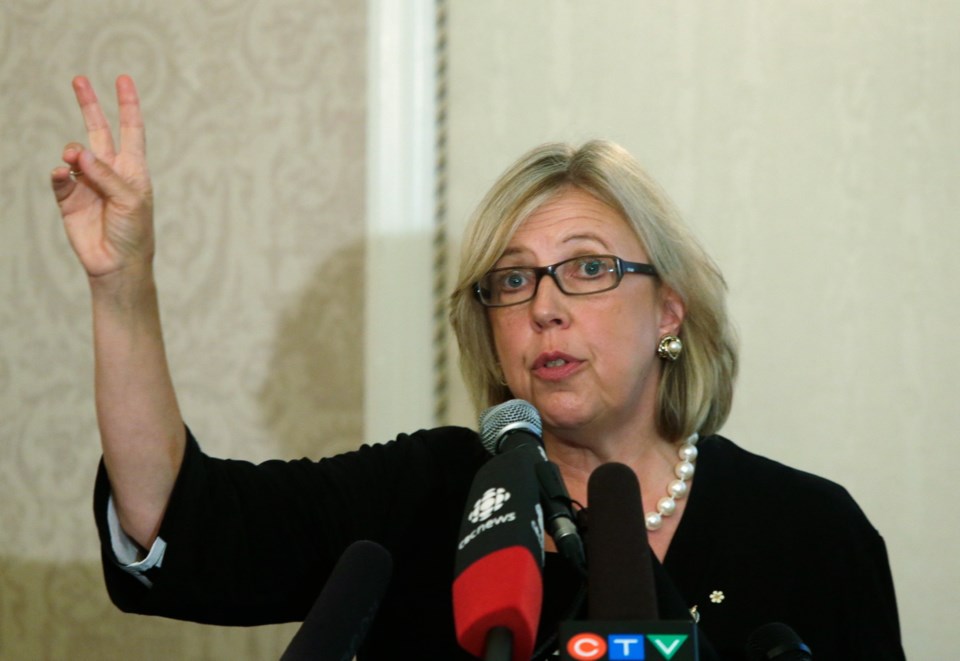House all the homeless across the country. Retrofit every Canadian home to maximize energy efficiency. Give every low-income person a guaranteed livable income to help them afford housing. This is where the Green party would like to take Canada.
But how much will it cost? And where will the money come from?
The answers, it turned out, were in the trunk of leader Elizabeth May’s white Toyota Prius.
May, flanked by local Green candidates, released the party’s housing strategy at a co-housing complex in north Burnaby on Tuesday. It includes the federal government reinvesting in affordable housing and co-ops, increasing access to social housing for First Nations living both on and off reserve and scrapping the immigrant investor program, which the Conservative government has already reduced to just 60 applications per year, up from almost 600 principal applicants — and just over 5,000 spouses and dependents — in 2010.
Nowhere in the party’s news release or accompanying backgrounder did it say how much this would cost or how the party would pay for it. When asked by The Vancouver Sun, May said the party would release its platform, fully costed, after Labour Day.
Redirecting one per cent of GST — about $6.4 billion based on last year’s revenues — to municipalities for infrastructure would be part of it, May said, but later acknowledged municipalities may have their own ideas about how to spend that money. The party would also introduce tax incentives to encourage construction of rental housing, which is where May argued the focus should be.
“I can tell you right now that not only is it costed, but we will run a balanced budget with a larger surplus than anything Mr. Harper is forecasting, and it’s responsible fiscally.”
When pressed for further details about the costs of these proposals after the news conference, May said she had some unreleased party budget documents in the trunk of her car. This is how a Sun reporter came to be standing in a parking lot Tuesday morning taking pictures of the contents of May’s trunk with an iPhone, earning quizzical glances from passersby.
Those documents show the party would spend $400 million next year, increasing each year to $1.3 billion by 2018-19, to establish a national affordable housing program. The goal would be to construct 20,000 new affordable housing units, renew 8,000 existing units and provide rent supplements for an additional 40,000 low-income families each year. The Greens would spend an additional $800 million per year to improve education, drinking water and housing conditions for First Nations communities, on and off reserve.
Funding would come from several sources, which include raising the corporate tax rate to 19 per cent from the current 15 (excluding small businesses, which would see their taxes reduced), cracking down on offshore tax havens, an estate tax on properties over $5 million and legalizing and taxing marijuana, May said.
Ann McAfee, a former housing planner for the City of Vancouver and an adjunct professor of planning at the University of B.C., called the Greens’ housing proposals “welcome, but not groundbreaking.”
“All the programs seem to rely on government funding. There’s not a lot in there which might see people helping themselves,” she said.
One example of this is encouraging the development of homes with “mortgage helper” suites, which serve the dual purposes of getting a young couple into the market and providing affordable housing, she said.
McAfee also questioned whether a guaranteed livable income would help with affordability, noting that some jurisdictions in the U.S. experimented with this concept in the 1970s. The result was that landlords increased rents because they knew their tenants had more money, she said.
May made the housing announcement in Burnaby, one of the region’s least affordable areas.
The city has a vacancy rate of 0.02 per cent, and a significant number of invisible homeless people who are couch surfing or sleeping in church basements, said Lynne Quarmby, the Green candidate for Burnaby North-Seymour. Many of these people are employed, she added.
Where the other parties stand on housing
Conservatives: The Conservatives have promised to collect data on foreign real estate speculation in the Canadian market and take action as necessary to curb it. They have also promised to increase the amount first-time buyers can draw from savings tax-free to finance a down payment to $35,000 from $25,000 and establish a permanent tax credit for home renovations.
Liberals: In a speech to the Federation of Canadian Municipalities in June, leader Justin Trudeau said the party envisioned a “renewed federal role in housing” that would include new investments in both supportive and affordable housing.
New Democrats: An NDP government would take $500 million from the Canada Mortgage and Housing Corporation to build affordable rental housing, leader Tom Mulcair said in June. He has also promised to renew federal operating agreements with housing co-operatives that are set to expire in the next few years.



